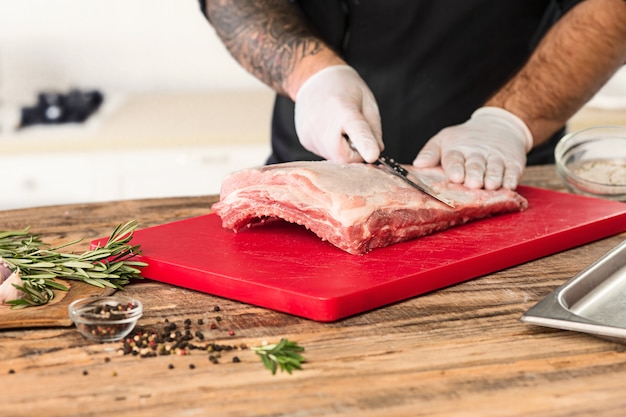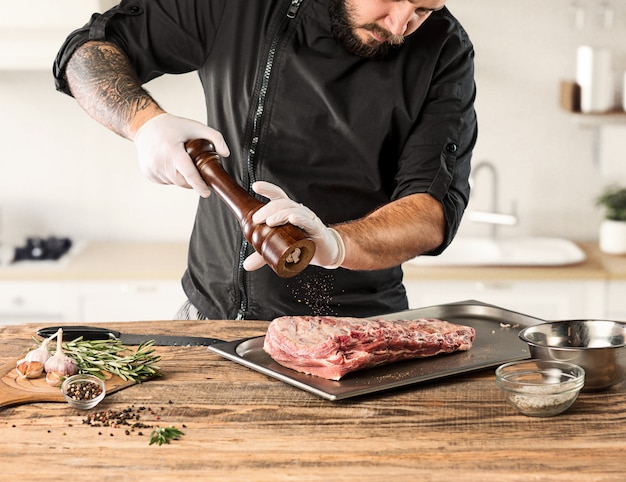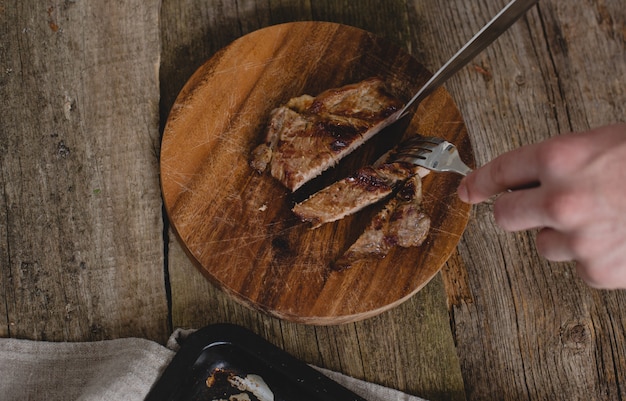Sirloin - A Cut Above

You can't just grab any old cut of meat and expect a Michelin-star worthy steak. You need to choose wisely, and in my opinion, sirloin is the way to go. It's a cut from the loin of the cow, which is known for its tenderness and flavour. It's also relatively affordable, making it a great choice for a weeknight dinner.
Know Your Sirloin

Now, within the sirloin family, there are a few different cuts. You've got your top sirloin, which is the leanest and most tender. It's often the go-to choice for people who prefer a leaner steak with a delicate flavour. Then there's the bottom sirloin, which is a bit more marbled and has a richer flavour. This cut is a great option if you're looking for a steak with a bit more depth and complexity. And then you have the tri-tip, which is a triangular cut that's known for its distinct flavour and tenderness. This cut can be a bit more challenging to cook, but the rewards are worth it.
Picking the Right Cut for You
Honestly, the best cut really depends on your personal preference and what you're after. If you want something lean and delicate, go for the top sirloin. If you prefer a bit more marbling and flavour, the bottom sirloin is your best bet. And if you're looking for something with a bit more character and a unique flavour profile, the tri-tip is the way to go.
Thick vs. Thin
Another important consideration is the thickness of your steak. A thicker steak will take longer to cook but will also retain more moisture and flavour. Aim for a steak that's at least 1.5 inches thick. This will give you plenty of room for a nice sear and a juicy, pink centre. You'll be able to achieve that beautiful gradient from a crispy, golden-brown exterior to a perfectly cooked, tender interior.(Part 2) Preparing Your Steak
The Art of Patting Dry

You know, I've learned the hard way that a perfectly cooked steak starts with proper preparation. First things first, pat your steak dry with paper towels. This will help to ensure a crisp sear and prevent the steak from steaming instead of grilling. A dry surface will create those beautiful, caramelized crusts that we all love.
Seasoning with Savour
Now, this is where the fun begins! Don't be afraid to get creative with your seasonings. Salt and pepper are the classics, of course, but I like to experiment with herbs, spices, and even a bit of garlic powder. Fresh herbs like rosemary, thyme, and oregano can add a wonderful aromatic dimension to your steak. I also love to use a pinch of smoked paprika for a hint of smokiness or a touch of chili powder for a subtle kick. Just remember to season generously, as the salt will help to draw out moisture and enhance the flavour.
Let It Rest
One mistake many people make is rushing the cooking process. Allow your steak to sit at room temperature for about 30 minutes before cooking. This will help the steak to cook more evenly and prevent it from being cold in the centre. The steak will cook more consistently and you'll avoid those cold spots that can sometimes ruin a perfectly good steak. (Part 3) The Importance of Temperature
Heat It Up!
Listen, a hot pan is your best friend when it comes to cooking steak. You want the pan to be screaming hot, almost smoking. This will create that beautiful crust, the one you see in all the steak pictures in cookbooks. The intense heat sears the surface of the steak, creating a delicious, crispy crust while locking in the juices inside.
Using a Thermometer
You know, it's tempting to rely on your instincts when cooking steak. But, trust me, a meat thermometer is your best friend! It will help you cook the steak to your desired level of doneness. A thermometer is a simple tool, but it takes the guesswork out of cooking steak and ensures a perfectly cooked steak every time.
Doneness and Temperature
Now, let's talk about the different levels of doneness. I've made a little table here to help you out:
| Doneness | internal temperature (°F) | Description |
|---|---|---|
| Rare | 125-130 | Cool red center, warm edges |
| Medium-Rare | 130-135 | Warm red center, hot edges |
| Medium | 140-145 | Pink center, fully cooked edges |
| Medium-Well | 150-155 | Very little pink, mostly brown |
| Well-Done | 160 | No pink, completely brown |
Remember, these are just guidelines. Ultimately, the best way to determine doneness is to use a meat thermometer.(Part 4) Cooking Methods
pan-seared steak - A Classic
Pan-searing is my go-to method for cooking steak. It's simple, efficient, and always delivers a delicious result. Just heat a heavy-bottomed pan over high heat until it's smoking hot. Add a tablespoon of oil and sear the steak for 2-3 minutes per side, or until it's nicely browned.
Grilling: An Outdoor Delight
If you've got a grill, you're in for a treat. Preheat your grill to high heat, and then grill the steak for 2-3 minutes per side, or until it's nicely charred. The smoky flavour from the grill just adds another layer of deliciousness to your steak.
reverse searing - A Slow and Steady Approach
Now, this is a technique I've learned to love. You start by cooking your steak in a low oven, about 250°F for 30 minutes. This method allows the steak to cook evenly without drying out. It's a great way to ensure a perfectly cooked steak that's tender and juicy throughout. Once the steak has reached your desired internal temperature, you can sear it on the grill or in a pan for those beautiful grill marks.(Part 5) Resting - The Key to Juiciness
Patience, My Friend!
No, you don't just get to dig in right after you cook the steak. Once your steak is cooked, you must let it rest for 5-10 minutes. This allows the juices to redistribute throughout the steak, making it incredibly tender and juicy.
The Science Behind It
Think of it this way. When you cook a steak, the juices are pushed to the surface. By letting it rest, the juices have time to soak back into the meat, resulting in a much more flavorful steak. You'll notice a dramatic difference in the texture and flavour of your steak if you simply give it a few minutes to rest. (Part 6) Slicing and Serving
A Perfect Slice
Okay, your steak is cooked, it's rested, and now it's time to slice and serve. I like to slice my steak against the grain, which makes it easier to chew and helps to enhance the flavour. But really, it's up to you.
The Grand Finale
Now, this is the moment you've been waiting for! Serve your steak with your favourite sides. Roasted vegetables, mashed potatoes, asparagus - the possibilities are endless. I love pairing steak with a simple salad with a light vinaigrette for a refreshing contrast or a creamy, cheesy gratin for a more indulgent experience. And don't forget the sauce! A red wine sauce or a béarnaise sauce can really elevate your steak to a whole new level. A good sauce can add a delicious complexity and depth of flavor to your steak, taking it from good to great.(Part 7) A Few Final Tips
Invest in Good Equipment
Honestly, you can't expect to cook a perfect steak if you're using subpar equipment. A good quality cast iron pan or a high-powered grill will make all the difference. A cast iron pan heats evenly and retains heat well, while a good grill will provide you with those delicious grill marks.
Don't Overcrowd the Pan
You need to give your steak room to breathe! If you overcrowd the pan, the temperature will drop, and your steak won't cook evenly. If you're cooking more than one steak, cook them in batches to ensure they have enough space to cook properly.
Be Bold with Flavour
Don't be afraid to experiment with different seasonings and sauces. Steak is a blank canvas for your culinary creativity. Try adding a pinch of smoked paprika, a sprinkle of chili powder, or a mix of herbs like rosemary and thyme. Or, get adventurous with your sauces and try a chimichurri sauce, a garlic butter sauce, or a creamy blue cheese sauce.(Part 8) FAQs
How to Tell if a Steak Is Cooked Through?
The best way to determine doneness is to use a meat thermometer. But if you don't have one, you can use the "finger test." Press the centre of the steak. If it feels firm and springy, it's medium-rare. If it feels softer and gives a little more, it's medium. And if it feels very firm and doesn't give at all, it's well-done.
How Long Should I Cook a Steak?
The cooking time will vary depending on the thickness of the steak and the cooking method. However, a general rule of thumb is to cook a 1-inch thick steak for 3-4 minutes per side for medium-rare. For a thicker steak, you'll need to cook it for a longer period of time to ensure it's cooked through.
What's the Best Way to Reheat Steak?
To reheat a steak without drying it out, place it in a preheated oven at 350°F for 5-10 minutes. Or, you can reheat it in a skillet over medium heat with a little bit of butter. Avoid microwaving your steak, as this can make it tough and dry.
Can I Marinate Steak?
Yes, you can marinate steak. Just make sure to marinate it in the refrigerator for at least 2 hours, or up to 24 hours. This will help to tenderize the meat and infuse it with flavour. A marinade can really enhance the flavour of your steak and make it even more delicious.
What Are the Best Cuts of Steak for Pan-Searing?
The best cuts of steak for pan-searing are the ones with a good amount of marbling, such as ribeye, new york strip, and sirloin. These cuts will stay juicy and flavorful even when cooked quickly. They have a nice balance of fat and lean meat, which helps to keep them juicy and tender when cooked with a quick sear.Remember, cooking a perfect sirloin steak is an art, but with the right techniques and a bit of practice, anyone can achieve delicious results. So, get your pan ready, and let's get cooking!
Everyone is watching

Corn on the Cob: The Ultimate Guide to Perfectly Cooked Ears
Healthy MealsAh, corn on the cob. Just the name evokes images of sunny days, barbecues, and that sweet, juicy flavour that ...

Perfect Pork Roast Oven Cooking Time: A Guide to Delicious Results
Healthy MealsThere's something truly satisfying about a perfectly roasted pork. The aroma alone is enough to make your mout...

Ham Cooking Time: How Long to Bake, Smoke, or Boil a Delicious Ham
Healthy MealsAh, ham. It's a classic, isn't it? A real crowd-pleaser, especially around holidays. And when done right, it'...

Scallops: The Ultimate Guide to Perfect Cooking
Healthy MealsAh, scallops. Those delicate, sweet, and utterly delicious morsels of the sea. They hold a special place in my...

Spaghetti Squash: The Ultimate Guide to Cooking and Serving
Healthy MealsRemember that time you saw spaghetti squash at the supermarket, looking all bumpy and strange, and thought, "W...
